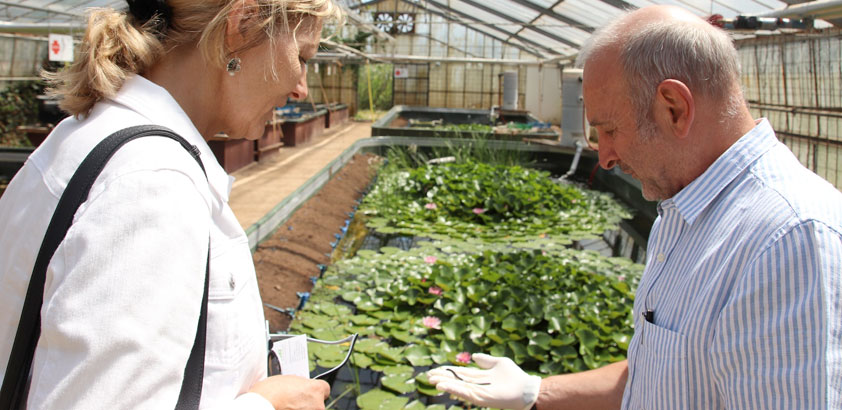
Downloads

Press release (german)![]() Download PDF...336.06 KB
Download PDF...336.06 KB
Leeches were the focus of District Administrator Anita Schneider's (left) visit and her guided tour with Dr Harald Galatis (right)
(Photo: District of Gießen)
District of Gießen. They can grow up to 20 centimetres in length, they’re brightly coloured, elegant swimmers and act as tiny therapeutic aids. During a visit to Europe's largest leech supplier, Biebertaler Blutegelzucht GmbH (bbez), District Administrator Anita Schneider discovered that leeches aren't disgusting worms, but tiny miracle weapons. bbez was founded as a project by ZAUG (Zentrum Arbeit und Umwelt, Centre for Work and Environment - a Gießen non-profit vocational training company), whose sponsors include the District of Gießen. bbez’s Managing Director, Dr Harald Galatis, took District Administrator Anita Schneider on a tour of the facility, which was formerly part of ZAUG. He showed her the most important departments, from breeding to shipping.
"It's impressive how successfully you have filled this niche in the market," stated Schneider. The company now sells around 500,000 leeches every year. Thanks to these healthy sales figures, the company has also grown from an initial 12 employees to 45 today. "By creating new jobs, you continue to strengthen the region and this boosting of employment also means that you are pursuing one of the original goals of the project initiated by ZAUG," said Schneider.
One of the reasons for the company’s strong growth is the fact that leeches have been officially classified as so-called proprietary medicinal products since 2004. Not only can leeches have a healing effect on animals such as horses, dogs and cats, they are also increasingly being used in human medicine. When leeches bite, painkilling substances secreted in their saliva enter the body. These substances can promote blood circulation, as well as having pain-relieving and anti-inflammatory properties. In this way, they can relieve localised pain for three to nine months – and all without major side effects or heavy blood loss. A leech ingests about five to six times its own weight in blood per meal. In addition, approximately the same amount of blood flows out from the bite. For an average one-gram leech, that's just ten to twelve grams of blood.
But how do you get the leech to “bite” in the right place? And what illnesses can it be used to treat? In order to communicate this, bbez offers training courses for doctors and non-medical practitioners. Every year, bbez trains more than 800 therapists in the correct use of leech therapy. After all, there are over sixty different areas of application where leeches can be of benefit, including in the treatment of osteoarthritis, rheumatism and even tinnitus. These small annelid worms have been proven to help with all of these complaints.
The potential of leech therapy was originally recognised by Dr Manfred Roth, the founder of Biebertaler Blutegelzucht (bbez). As a project developer at ZAUG, he initiated the bbez project. In 1989, ZAUG bought the site of a former garden centre in Biebertal and created new job opportunities for the socially disadvantaged and long-term unemployed in the breeding of leeches. Thanks to healthy sales and leeches being classified as proprietary medicinal products in 2004, the social project became an independent company in 2008.
In addition to breeding its own leeches, bbez also purchases leeches from Turkey and Romania. The leeches are then placed in special ponds and kept without food for 32 weeks before shipping. This ensures that the leeches are "more willing to bite" during therapy, as well as eliminating the risk of potential viruses.
